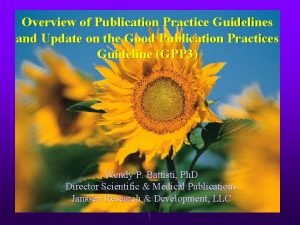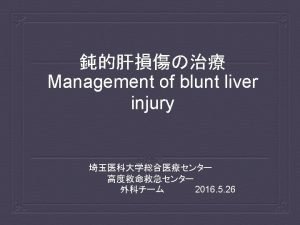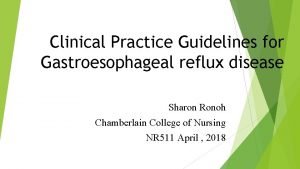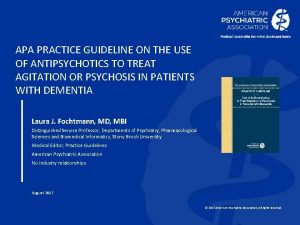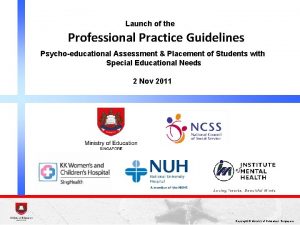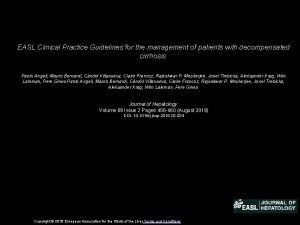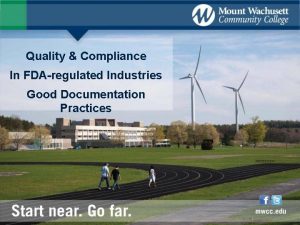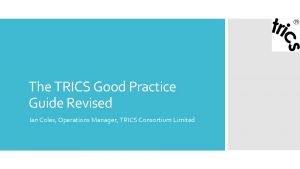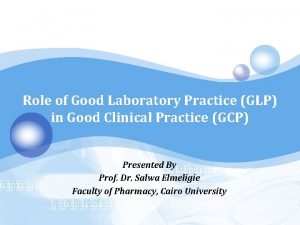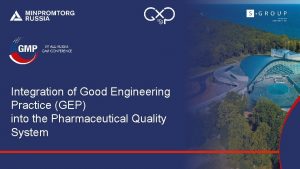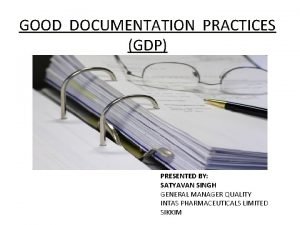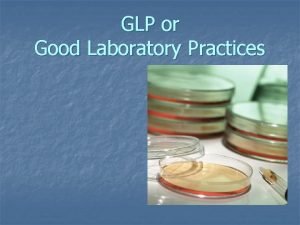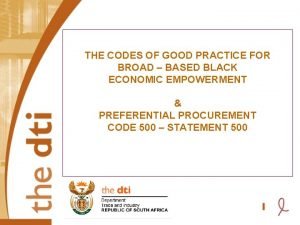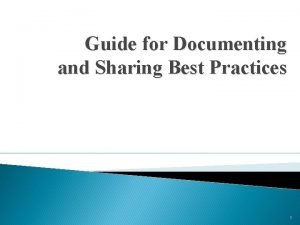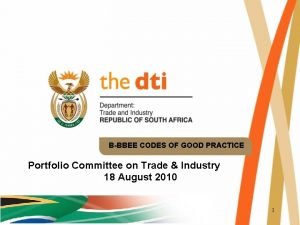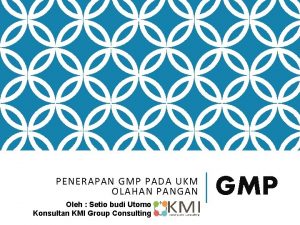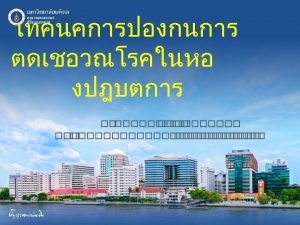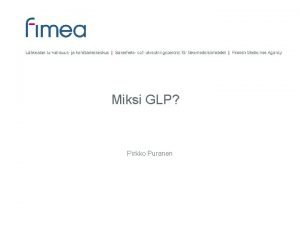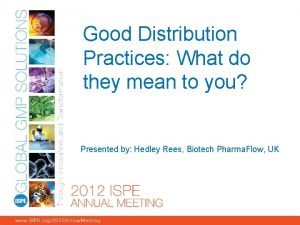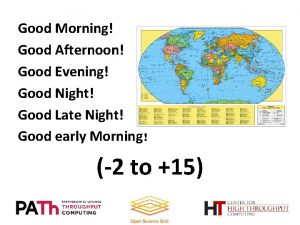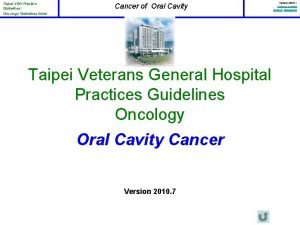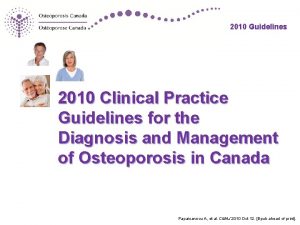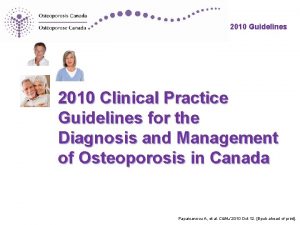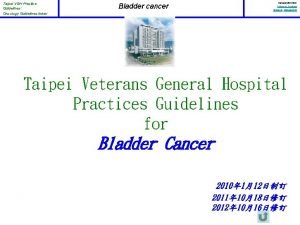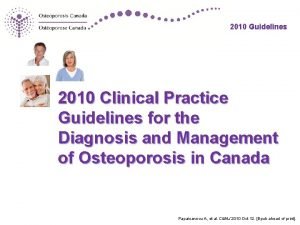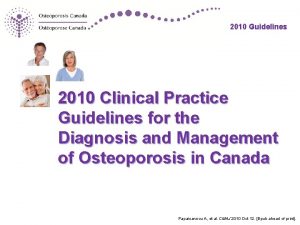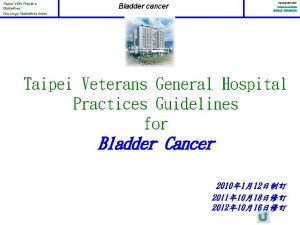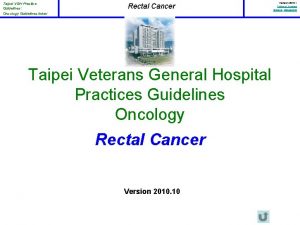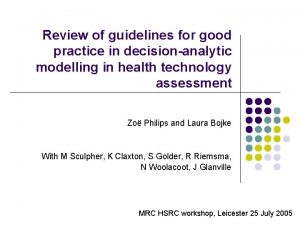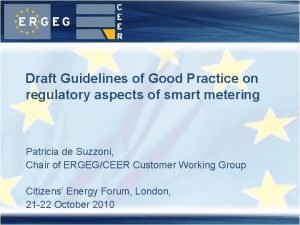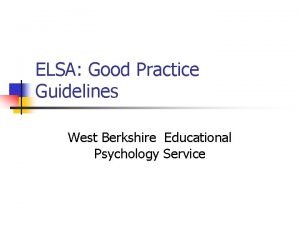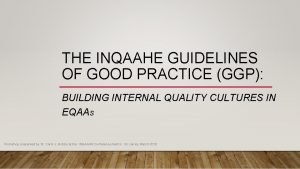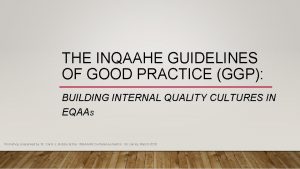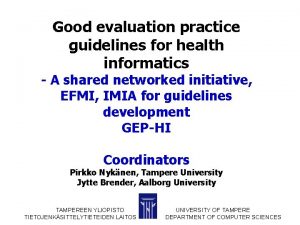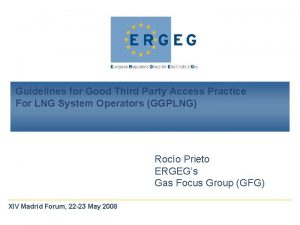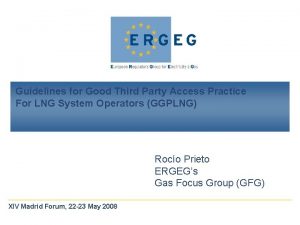Practice Guidelines l l l The Good The




























- Slides: 28

Practice Guidelines l l l The Good, The Not-So-Good The Ugly 1

Where do practice guidelines come from? l Trust us, we’re the experts: Opinion-based/ consensus guidelines • l Trust us, we have the evidence: “Evidencebased” • l Whose opinion? Do they have a conflict of interest? What is their perspective? How was the evidence used? Patient-oriented? Values? Evidence-linked: • • Here is how we found the evidence, used the evidence Strength of recommendation noted

Guidelines: Ultimately a social exercise l l Evidence: It is what it is The human touch: • Social judgment layered on top of the evidence 3

Breast Cancer Screening and the USPSTF The Evidence

How They Arrived at these Conclusions l Meta-analysis of 8 randomized controlled trials (RCTs) • Invited a total of 348, 219 women at age 40 yrs for • • • yearly screening 0 -3 studies, individually, showed a decrease in breast cancer mortality Meta-analysis: Combining results from all trials and analyzing the results Results:

Figure. Nelson HD. Screening for breast cancer: An update for the U. S. Preventive Services Task Force. Ann Intern Med 2009; 151: 727 -737.

Benefits 10, 000 women ages 40 -49 yrs screened yearly 15% 5 . 025% 1, 904 ? • Relative risk reduction in BC-related mortality • Credible interval 4% - 25% • BC-related deaths eventually prevented • Difference in rates of BC-related deaths • Attributable risk reduction (0. 319% vs 0. 294%) • Number needed to screen to prevent 1 BC-related death over 11 -20 yrs • Credible interval 929 – 6, 378 • Decrease in all-cause mortality as the result of screening USPSTF Recommendation Statement. Ann Intern Med 2009; 151(10): 716 -726

USPSTF Recommendation Grades, 2009 A • Recommended • High certainty of substantial benefit B • Recommended • High certainty of moderate benefit OR • Moderate certainty of high benefit C • Recommend against • Moderate or high certainty of small net benefit D • Recommend against • No benefit OR • Evidence or harm I • Insufficient evidence to weigh benefits and risks

USPSTF Recommendation Statement: Breast Cancer Screening A • None B • Women ages 50 -74 years • Screen every two years • Moderate evidence of moderate benefit C • Women ages 40 -49 years • Moderate or high certainty of small net benefit • May be suitable for some D • Self exam at any age I • Screening in women > 75 years • Clinical exam • Digital mammography, MRI

Why Does The Benefit Seem To Be So Small?

Breast cancer mortality vs all causes of mortality, all ages Black WC, et al. All-Cause Mortality in Randomized Trials of Cancer Screening. Journal of the National Cancer Institute, Vol. 94, No. 3, 167 -173, February 6, 2002

Causes of death in women, by age Bunker JP, Houghton J, Baum M. Putting the risk of breast cancer in perspective. BMJ 1998; 317: 1307 -9.

But What About “ 1 -in-8”? Age Ave lifespan = 79 years Risk 25 -34 1 in 2873 35 -44 1 in 474 45 -54 1 in 136 55 -64 1 in 65 65 -74 1 in 39 75 -84 1 in 26 85 -94 1 in 8 Bunker JP, et al. Putting the risk of breast cancer in perspective. BMJ 1998; 317: 1307 -9.

Risks 10, 000 women ages 40 -49 yrs screened yearly 30 -56% 33% 20% 10 -30% • At least one false-positive mammogram over 10 years • Women with DCIS undergoing mastectomy • Women screened yearly who will have at least one breast biopsy between the ages of 4050. • Rate of overdiagnosis (pseudodisease) • Women diagnosed and treated who were never destined to be affected by BC USPSTF Recommendation Statement. Ann Intern Med 2009; 151(10): 716 -726

Pseudodisease (overdiagnosis) l A condition that looks just like the disease, but never would have bothered the patient • Disease that would never cause symptoms • Asymptomatic disease in people who will die from another cause before disease presents l An estimated 10%-30% of breast cancers found and treated would have never affected the patients • The question: which ones? Cochrane Database Syst. Rev. 2009; CD 001877 doi: 10. 1002/14651858. CD 001877. pub 3

Overdiagnosis bias Gigerenzer G, et al. Helping doctors and patients make sense of health statistics. Psychological Science in the Public Interest 2008; 8(2): 53 -96.

Evaluating Screening Tests Evidence Judgment: l Sensitivity &specificity Is it worthwhile (to l Does it change an individual and/or diagnoses? l Does it change treatment? l Does it change outcomes? society)? Fryback DG, Thornbury JR. The efficacy of diagnostic imaging. Med Decis Making 1991; 11: 88 -94

Can We Trust Guidelines from Specialty Societies? Or Never ask a barber if you need a haircut 18

“. . . The guild of health care professionals – including their specialty societies – has a primary responsibility to promote its members’ interests. . . Quanstrum KH, Hayward RA. Lessons from the mammography wars. N Engl J Med 2010; 363: 1076 -1079 19

. . . It is a fool’s dream to expect the guild of any service industry to harness its self-interest and to act according to beneficence alone – to compete on true value when the opportunity to inflate perceived value is readily available. ” Quanstrum KH, Hayward RA. Lessons from the mammography wars. N Engl J Med 2010; 363: 1076 -1079 20

Screening for breast cancer: yearly at age 40 l l l American College of Radiology Society of Breast Imaging American Society of Breast Disease American Cancer Society ACOG

“Evidence-based” and the evolution of evidence: subclinical hypothyroidism Step 1 l l Search of 10 databases Studies summarized 12 experts rated the evidence Recommendations: • • “Recommend against routine screening for subclinical hypothyroidism” “Recommend against routine treatment of 4. 5 – 10. 0 m. IU/L” Surks MI, et al. Subclinical thyroid disease. Scientific Review and Guidelines for diagnosis and management. JAMA 2004; 291: 228 -238.

“Evidence-based” and the evolution of evidence: subclinical hypothyroidism Step 2: l Consensus meeting among members of the American Association of Clinical Endocrinologists, The American Thyroid Association, and The Endocrine Society. l New recommendation statement l Recommendations sent to leadership of the organizations

The evolution of evidence: subclinical hypothyroidism The result: l l New recommendations from the three societies: • • Most patients with TSH levels 4. 5 – 10 m. IU/L should be treated Shouldperform routine screening for subclinical hypothyroidism Why? • “Although good evidence is unavailable [to support our recommendation], there is a sizable amount of fair evidence and an abundance of opinion by experts. . . The [scientific panel recommendations] are contrary to the practice of many. . . experts” Gharib H, et al. Consensus statement: Subclinical thyroid dysfunction: A joint statement on management from the American Association of Clinical Endocrinologists, The American Thyroid Association, and The Endocrine Society. J Clin Endocrinol Metab 2005; 90: 581 -5.

Bilirubin in term infants (Sept 2009) USPSTF: Summary of Recommendation “The U. S. Preventive Services Task Force (USPSTF) concludes that the evidence is insufficient to recommend screening infants for hyperbilirubinemia to prevent chronic bilirubin encephalopathy” American Academy of Pediatrics Restatement and Clarification “. . . We recommend universal predischarge bilirubin screening, which helps to assess the risk of subsequent severehyperbilirubinemia. We also recommend a more structured approachto management and follow-up according to the predischarge TSB/Tc. B, gestational age, and other risk factors for hyperbilirubinemia. These recommendations represent a consensus of expert opinionbased on the available evidence, and they are supported by severalindependent reviewers. Nevertheless, their efficacy in preventingkernicterus and their cost-effectiveness are unknown. “

Evidence Linked Guidelines l l Brief Summary Statement for each recommendation Detailed Discussion of the evidence Long Reference section pointing to original research Methods section showing how evidence was obtained and evaluated

Evidence Linked Guidelines t n me e f ie Br t a t s Evidence table Detailed overview of the evidence

National Guideline Clearinghouse l l l www. ngc. gov Vetted guidelines from various groups Standard organization so that information can be compared across various guidelines 28
 Good regulatory practice guidelines
Good regulatory practice guidelines Good publication practice guidelines
Good publication practice guidelines Google
Google Hi good afternoon
Hi good afternoon Good afternoon buenas tardes
Good afternoon buenas tardes If you are
If you are Hello teacher good afternoon
Hello teacher good afternoon East guideline
East guideline Gerd clinical practice guidelines
Gerd clinical practice guidelines Apa practice guidelines
Apa practice guidelines Moe professional practice guidelines
Moe professional practice guidelines Easl 2018 decompensated cirrhosis
Easl 2018 decompensated cirrhosis Good documentation practices
Good documentation practices Myeplg
Myeplg Trics good practice guide
Trics good practice guide Logo who
Logo who Gep good engineering practice
Gep good engineering practice Document
Document Good laboratory practice examples
Good laboratory practice examples Bee codes of good practice
Bee codes of good practice Sharing good practice definition
Sharing good practice definition Susu farming
Susu farming Bee codes of good practice
Bee codes of good practice Pengertian gmp
Pengertian gmp Ruang lingkup cppob
Ruang lingkup cppob Good microbiological practice
Good microbiological practice Good laboratory practice
Good laboratory practice Gpp good pharmacy practice
Gpp good pharmacy practice Eu good distribution practice
Eu good distribution practice

